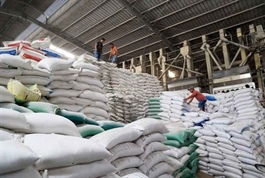VN's consumer gold demand impacted by global economic trends in 2023
VN's consumer gold demand impacted by global economic trends in 2023
The World Gold Council’s Gold Demand Trends report reveals that annual gold demand (excluding over-the-counter) fell to 4,448 tonnes in 2023, down just 5 per cent from a notably strong 2022.

SJC gold bars are displayed for sale in Hà Nội. — VNA/VNS Photo Trần Việt |
Việt Nam saw a slight drop in overall consumer demand, down 6 per cent year-on-year, from 59.1 tonnes in 2022 to 55.5 tonnes in 2023. Bar and coin sales also saw a modest year-on-year decline in 2023, settling at 40 tonnes, reflecting a marginal decrease of tw tonnes.
However, Việt Nam experienced a substantial downturn in jewellery demand, dropping by 16 per cent to 15 tonnes. This decline was marked by four consecutive quarterly year-on-year decreases, attributed to slowing economic growth and relatively high inflation in the region.
Shaokai Fan, head of Asia-Pacific (ex-China) & global head of Central Banks at the World Gold Council, said: "In Q4, Việt Nam experienced an investment surge propelled by a price correction; however, increased demand and limited gold investment options led to a substantial premium on official SJC tael bars, reaching approximately US$600-700 per ounce.
"The steady decline in the value of the local currency throughout 2023 further fueled demand, especially amid a fragile economic environment."
Turning to bar and coin investment, global demand was subdued and down 3 per cent as strength in some markets worked to offset weakness elsewhere. In other ASEAN markets, including Việt Nam, Malaysia, Indonesia, and Singapore, bar and coin demand also experienced a decline of 2 per cent, 4 per cent, 5 per cent, and 8 per cent, respectively, year-on-year.
Meanwhile, the global jewellery market proved to be remarkably resilient amidst record-high prices as demand inched up by three tonnes year-on-year. China played an important role, recording a 17 per cent increase in demand for gold, as it recovered from COVID-19 lockdowns, offsetting a 9 per cent decrease in India.
























